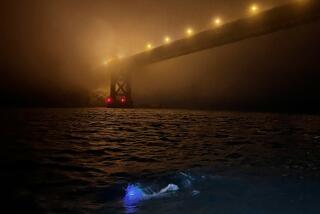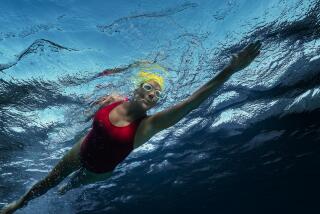Orange County Woman Swims to Soviet Union
- Share via
BIG DIOMEDE ISLAND, Soviet Union — Exhausted, half-frozen but exhilerated, Lynne Cox stumbled ashore to a Russian picnic buffet here Friday after swimming the icy Bering Strait from Little Diomede Island in the United States to the Soviets’ Big Diomede in 2 hours, 5 minutes.
A temporary thaw fell upon the chilled waters with the historic swim of the cheerful, 30-year-old Los Alamitos woman, who brought the superpowers together in glasnost for a day.
“Obviously, this isn’t just about swimming,” she said afterward. “The swimming part was a challenge, but it was everything else that made it special.”
Vitaly Medjannikov, a Soviet swim coach who was in the reception party, said in broken English: “This is very much risk, very difficult. Lynne Cox is a hero, a women’s hero.”
Until Cox fulfilled an 11-year ambition to swim the 2.7-mile part of the strait where the International Dateline marks the only common border between the United States and the Soviet Union, nobody had even attempted it.
The water freezes over in the winter, when interlopers have walked across and been sent back by Soviet officials. Friday it was 44 degrees Fahrenheit, and Cox swam it without a wet suit or grease over her thin Speedo swimsuit.
Accompanied by an entourage of coaches, physicians, reporters, Eskimo villagers and, for the last part of the journey, the Soviet Navy, Cox maintained a pace of 70 strokes per minute. At times fog limited visiblity to 100 yards, but the northerly current was weaker than expected at about three-quarters of a knot. Because of the current, she could not churn directly across the Strait and had to swim four to six miles.
It was only at the end, she said, that she tired and the current became a problem.
“It felt like I was in a big dishwasher,” she said. “I could feel it zigzagging and I got caught in the folds of it.”
Along the way scientists, accompanying her in walrus-skin boats called umiaks, monitored her temperature with a thermosensitive capsule called a “radio pill” that was attached to her body and transmitted a signal to an instrument on the boat. Cox would roll over and backstroke for a minute while the doctors held an aerial over her stomach on the end of a long stick to take her temperature.
Dr. William Keatinge, an expert on hypothermia from the London Medical College, said Cox’s success “showed somebody with Lynne’s body composition and determination can get across in this water. Most people would get into trouble very quickly.”
Cox is 5 feet, 6 inches and 180 pounds. Keatinge estimated her body fat content at 35%, giving her important insulation from the cold.
“Her temperature had fallen a half-degree halfway across, but we weren’t able to get further readings until she had landed,” Keatinge said. “However, 10 minutes after she landed her temperature was 94--just on the margin of hypothermia.”
“She was well within her safety limits, but in a place this remote we didn’t want to take any chances. She was fighting the current, and if it had been any colder she could have been in trouble.”
Cox started her long-distance swimming career in 1972 when she set a record--for men or women--for an English Channel crossing of 9 hours, 57 minutes. She was 16 years old. Four years later, bored with repeating the usual long-distance swims, she started plotting to swim the Bering Strait and other cold-water goals--most of them shorter and not quite as cold--while earning a degree in English from UC Santa Barbara.
It paid off Friday.
She had expected a stronger current to push her toward the north end of Big Diomede, and there was some fear that it might carry her beyond the island completely and into the Chukchi Sea. But she maintained a steady southwesterly course, occasionally corrected at the direction of Eskimos familiar with the waters.
Soviet officials, who had not given permission for the swim until Thursday, sent a 30-foot navy launch to escort her from the international dateline to the shore of this rocky island. The launch also discouraged the four small spectator boats from Little Diomede from proceeding beyond the unmarked boundary.
Later, Lt. Col. Vladimir Starikov, the commander of the island garrison, asked Cox’s project director, Joe Coplan: “Why didn’t your (Coast) Guard follow you from your side?”
Coplan replied: “That’s a good question.”
Coplan, who said he was also refused money by more than 50 U.S. corporations, had requested Coast Guard participation but was told the service had no vessels available in the area.
At one point, Coplan asked Cox: “Lynne, what day is this?”
“It’s tomorrow,” she yelled back happily, referring to the time change at the dateline and sensing that her goal was within reach. Finally, the high, steep cliffs of Big Diomede became visible.
Soviet officials had set up a warming tent and two buffet tables, with a waiter in a white smock serving hot tea, bread, dried fish and chocolate-covered coconut candy. And what appeared to be two uniformed army officers watched with binoculars and cameras from a hill directly above.
“They went all out for us,” Cox said. “Half a mile offshore I saw people lining the beach. It was wonderful.”
While Cox recovered, the party proceeded outside the tent with exchanges of pins and whatever paraphernalia people had in their pockets. Soviet helped American, and vice versa, as they tried to keep their balance on the boulders.
But until the previous day there had been apprehension in Cox’s camp about what kind of reception they would receive from Soviet officials if they even ventured across the dateline. There had been no contact since July 23, when the Soviet officials asked what services Cox wanted from their side.
Then on Thursday Soviet officials sent telexes back confirming their cooperation, and the swim was full speed ahead. All Cox had to deal with was the elements.
Moscow had been told that Cox planned to swim between Aug. 5 and 12 and, noting Thursday’s calm conditions, fully expected her then.
“Where were you yesterday?” they asked members of her party.
But Cox had been grounded a day at Wales on the Alaskan mainland before she could proceed 26 miles offshore to Little Diomede by helicopter Thursday afternoon.
“I had some doubts right at the end because the water dropped 4 or 5 degrees,” she said.
Coplan said it was more likely that she just started to feel colder as the exposure took its toll. He told her to “aim for the snowbank” just above the beach where the Soviet officials were waiting.
Cox: “I was thinking, ‘I don’t want to land by the snowbank. I’m already cold enough. I want to land at those rocks.’ I cooled real fast at that point. The boat . . . I was getting fumes, and I was not happy with what I was doing.”
After Cox landed, Dr. Keatinge fussed impatiently as she received a bouquet of wildflowers and a pair of Eskimo slippers and was interviewed briefly for Soviet TV. Then she was helped awkwardly over the boulders to the warming tent 75 yards away.
“In those 10 minutes walking along the beach, she probably just went into hypothermia,” Keatinge said.
But she remained coherent as hot packs were applied and she was wrapped in a warming bag that circulated hot air around her body. She remained in the tent for 90 minutes, lying on a cot while Keatinge and Dr. Rita Sacharova, a Soviet sports medicine specialist, attended to her.
Emerging later, Cox surveyed the scene and said: “I can’t believe that we are really here and that people are speaking Russian to us and it’s a sunny day in Siberia.”
She exchanged gifts with her Soviet hosts, and Mikhail Sverlov, representing the U.S.S.R. Sports Committee, invited Cox and Coplan to Moscow.
“Whenever they want us,” Coplan said.
Lynne Cox’s journey was also an occasion of joy for others.
The primary umiak in her escort group was commanded by Patrick Omiak, the mayor of Little Diomede, where 158 Eskimos live in small houses clinging to the edge of the steep slopes.
Upon reaching the other side, Omiak met two cousins he hadn’t seen in nearly 40 years. Soviet officials had brought them from the Siberian mainland, where the Big Diomede Eskimos were moved when the Soviets made the larger island a military observation post in 1948, breaking up several Eskimo families.
The Eskimos chatted happily and sang folk songs on the rocky beach for more than three hours before Cox’s expedition returned to Little Diomede.
“This is the happiest day of my life,” Omiak said.
For Cox it was, too.
More to Read
Sign up for Essential California
The most important California stories and recommendations in your inbox every morning.
You may occasionally receive promotional content from the Los Angeles Times.













